Hanging mid-air ten floors up, a shiny metal robot works its magic. This is no ordinary robotic workspace; this robot cleans away the dirt accumulated on the leading edge of a wind turbine. Controlled by four long cables attached to winches on the ground, the robot is a puppet whose strings are carefully pulled to orchestrate a wide variety of tasks from cleaning to inspection to repair, all suspended hundreds of feet off the ground and can be swapped easily by simply swapping the arm attached.
This robot platform, developed by Aerones, a Latvian company, has already worked on 12,000 blades from 5,000 turbines across 19 countries since it debuted in 2018. The robot is set to relieve the shortage of rope access technicians in the industry and reduce the cost of Operations and Maintenance (O&M) for wind farm operators.
While the robot platform is successful today, its birth was not a smooth one.
From firefighting to wind farm maintenance
Believe it or not, at the beginning, there was no winch system anywhere to be seen or even wind turbines for that matter. Aerones actually started off building drones for firefighting. Dainis Kruze and Janis Putrams, the two co-founders, started the company with the core observation that there was a lot of robotics happening either on the ground or in the air - for example, mobile robots and mechanical arms solidly stay on the ground and drones dominate the skies. There was nothing in the middle range, where there were clearly many industrial tasks, such as window cleaning and firefighting, to be done. Currently those tasks are done by rope-access technicians either through roof tops or helicopters, a dangerous task done dangling on a rope.
Leveraging this insight, Aerones’ first product was a heavy-lifting drone as a generalized automation platform that had the potential to do a wide range of tasks in the middle height range. They made one, and generated thousands of views on Youtube, but they couldn’t find a market. They tried window cleaning, firefighting and human-rescue, none of which were big enough markets to justify the cost.
The eureka moment came serendipitously at a drone convention in 2018. A helicopter pilot approached their booth and joked that their drone would take his job away. When they asked more, he explained that he flies helicopters to clean and apply ice-phobic coatings for wind turbines. At that point, the wind turbine maintenance market was just starting to take off as more turbines were being built throughout Europe. Pulling on that loose thread, they asked for an introduction to the wind farm operator, who ended up becoming their first client.
The two co-founders worked in their garage to get the drone to work with the blade cleaning task. It worked - sort of - but the drone swung a lot in the wind making the cleaning imprecise. After trying many different ways to stabilize the drone, they were still not getting the desired results.
What to do now? As they went through Y Combinator, the renowned startup accelerator, the idea of “make something people want” was planted in them. Here’s the big market they’d been looking for - the wind turbine O&M market that was valued at $33 billion. However, their original solution cannot properly serve this market. Putrams says that their perspective changed from “looking for a market for our drone” to “Here, we have a client that has a problem. How would we solve this?” That’s when they decided to drastically change the solution.
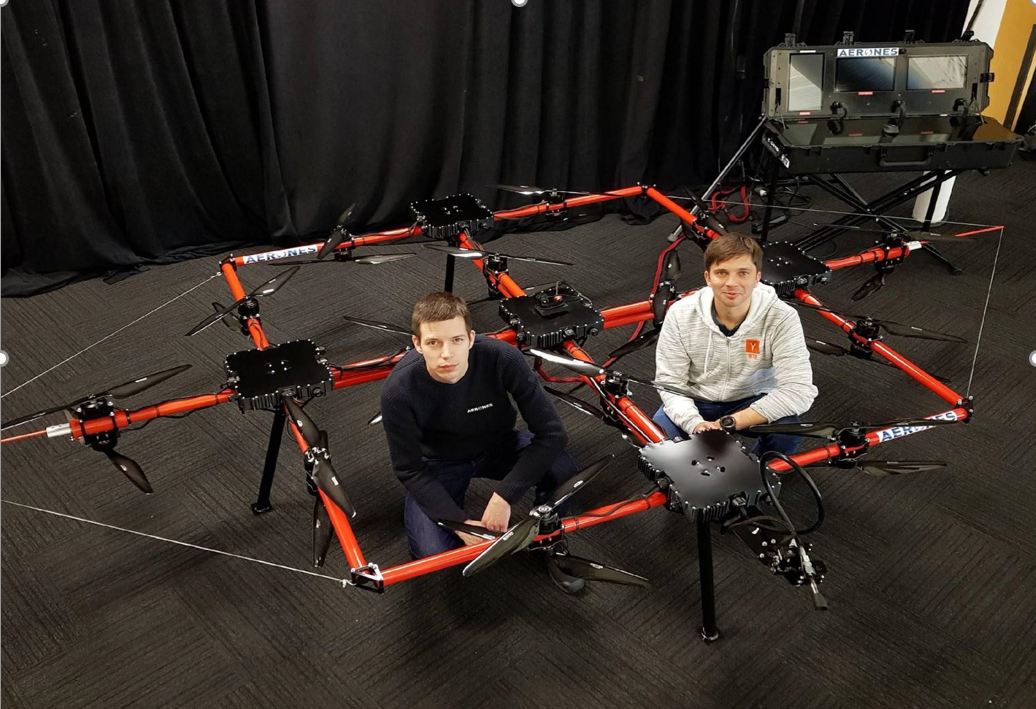 Janis Putrams (left) and Dainis Kruze (right) with a firefighting drone prototype.
Janis Putrams (left) and Dainis Kruze (right) with a firefighting drone prototype.
Evolving from drones to tethered robots
Their first goal was to prevent the drone from moving while carrying out the task. This was achieved by attaching three ropes fixated on the ground using three winches. This ensured the drone was fixed in the x-y plane and wouldn’t be perturbed by wind, so it only needed to provide the lift force to keep itself at the same z height. This structure greatly improved the stability.
Unfortunately as the team worked on the drone, they reached its limitations. For one, they were always bound by the weight - the size of the drone grew exponentially with the payload. Doubling the payload meant quadrupling the size of the drone. Any change in weight had to be scrutinized, severely limiting their functionality. If the drone had 1 brush but they wanted another one to better carry out the task, they had to cut something else off.
Another downside of the drone was it needed to be perfect from the beginning. Any small mistake could crash the drone, leading to a 2 month rebuild time. This significantly slowed down the engineering iteration speed, which was key to the survival of an early-stage company.
In light of these reasons, they ended up ditching the drone altogether by adding a fourth cable to lift up the drone, or, rather, now a robot platform, because it didn’t fly any more. This turned the system into something like “a 3D printer upside down” and made their life a lot easier. Without the weight limit, they could add power tools and connect the platform to high pressure water from the ground. The movement of the robot was even more precise because of the stable lift force. As an added bonus, they didn’t need to worry about drone permits anymore. This design pivot greatly sped up their engineering speed and ability to onboard new use cases for the robot platform.
A day with an Aerones robot
Fast forward to today, Aerones’ robot platform can carry out a wide range of O&M tasks, ranging from cleaning and inspection to simple repairs.
A normal day involves three technicians visiting the wind turbine in a small truck. To start, they set up the winch system to retract the ropes that will position the robot platform. Then, they attach the arm to the robot corresponding to the specific task. After that, they can sit comfortably and safely in the van remotely controlling the robot to carry out the task. Occasionally, a technician will oversee the operations from inside the wind turbine.
Aerones’ technicians no longer have to hang by a rope to carry out the operations themselves. This has drastically changed the job definition of wind turbine O&M technicians - they can now be more focused on the technical parts of the job without worrying about their safety all the time - this not only ensures their safety but also enables them to do their job better and more efficiently, thus saving costs for the wind turbine operators.
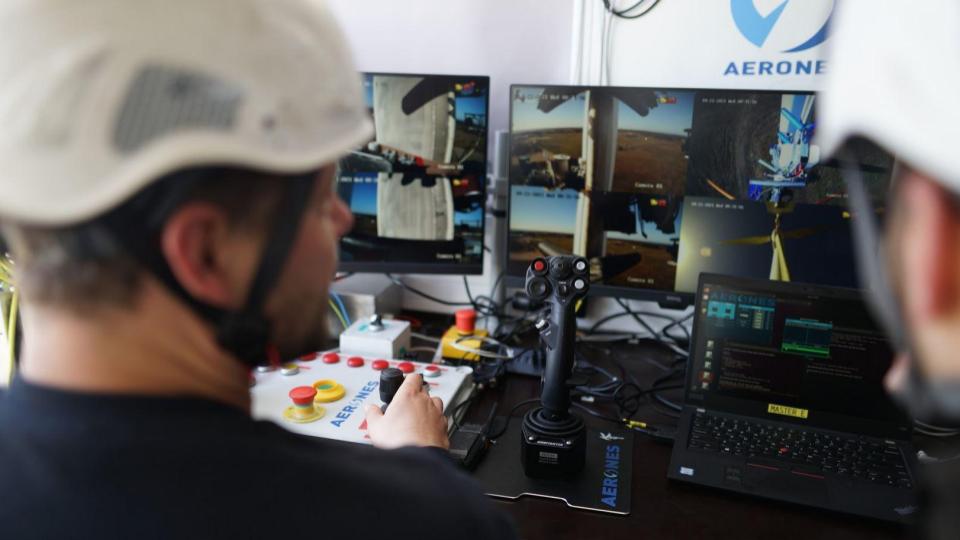 Aerones technicians remotely controlling the robot.
Aerones technicians remotely controlling the robot.
But why stop there? To further improve operations efficiency, Aerones can remove the travel step as well. Soon, technicians will be able to remotely control the robots from anywhere in the world by utilizing satellite Internet provided by, for example, Starlink. This will allow their technicians to oversee more O&M tasks per day by minimizing travel and setup time.
The business model: Robot as a service
To minimize the cost for customers, Aerones doesn’t sell their robot platforms directly. Instead, they provide robotic wind turbine maintenance services through their subsidiary firm Aerones Nordic. They hire and train their own technicians, who travel to the client sites across Europe, North America and Latin America to provide maintenance services.
Aerones customers include wind turbine manufacturers, owners and operators. According to Kārlis Upsavs, Aerones’ marketing manager, people rarely realize that wind turbines need so much maintenance in order to stay functional. The biggest demand for their robots so far has been blade and tower cleaning - washing away the hydraulic oil to improve the aerodynamics of the blades and to avoid polluting the ground as specified by regulations. Aerones robots use a biodetergent that doesn’t pollute the ground and catch the runoff in a skirt at the base of the tower to collect the dirty water for reuse after filtering since there’s limited access to water onsite.
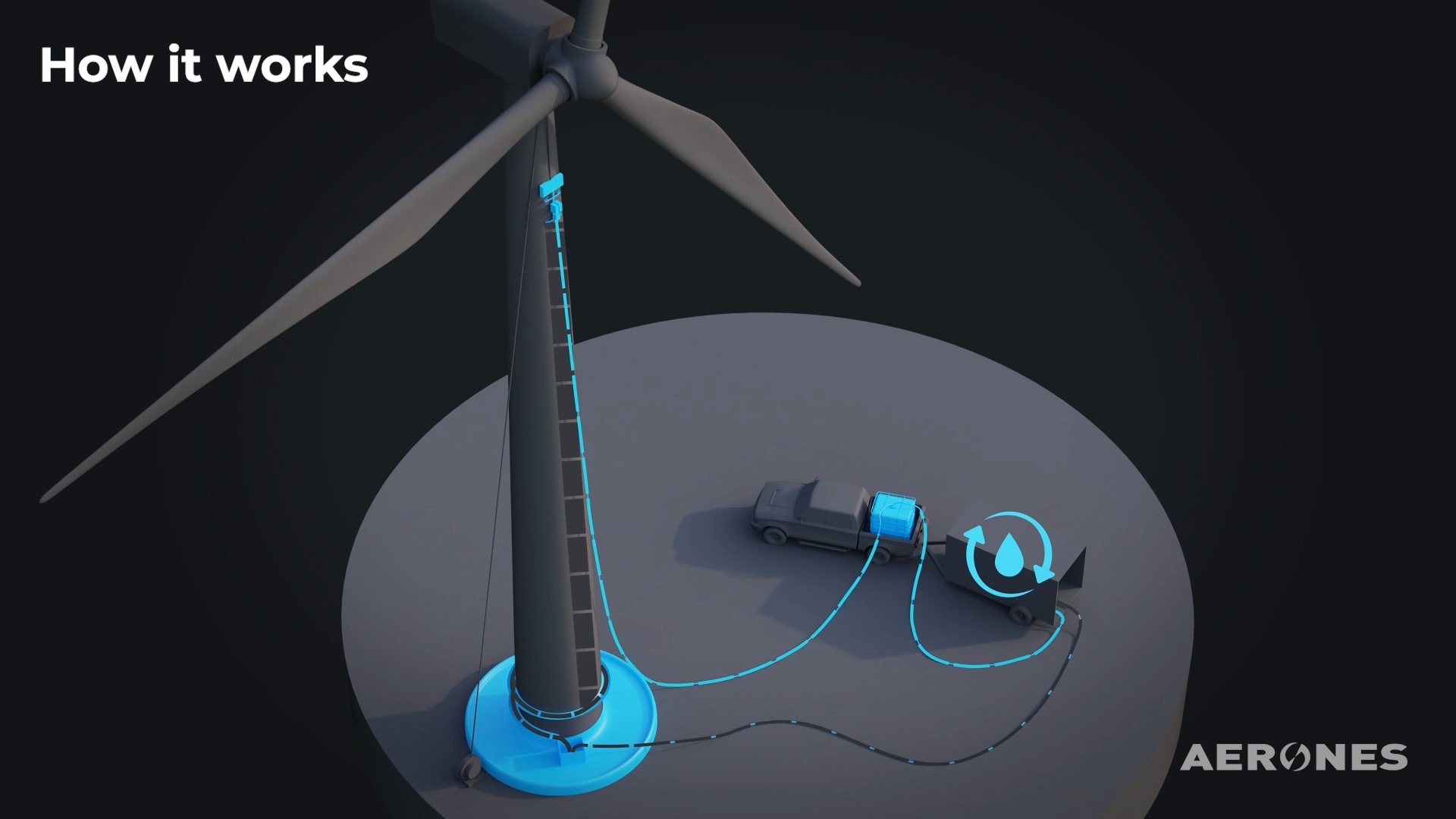 Aerones water collection and filtration system.
Aerones water collection and filtration system.
Because of the amount of data the robot platform collects up close while it cleans, Aerones also provides a client-side platform to present the relevant data after finishing the service. The data helps customers better understand the performance of the wind turbine and the operations work done and allows the customers to detect existing or potential issues by providing a comprehensive view of the turbine health. This differentiates them from most other O&M providers which only provides high-level reports and images from individual tasks.
Aerones directly charges customers for both the services delivered and the data analytics. As for other value propositions, the team also views themselves as an insurance tech - by regularly cleaning and repairing the blades and towers, Aerones helps make the turbines run for a long time with max efficiency by preventing blade deterioration, risk of breakdown and energy production losses. The company is considering working with insurance companies as part of the due diligence process. Their lightning conductivity inspection test is a cheap and great way to collect data about the lightning protection system, one of the leading claims in the industry.
As for competition, the only alternative solution on the market for such services are rope-access technicians dangling high up in the air. The job is dangerous, slow and expensive. There are also drones that do inspections, but they can only perform external visual inspections due to the limitation of stability and payload. There are several other companies working on sensors for internal inspection or climbing robots for blade repairs. However, those are mostly still in the early prototype stage.
Looking forward
There are approximately 500,000 wind turbines globally and the market is growing rapidly given the increased demand for sustainable energy. By extension, the wind turbine O&M market is valued at $33 billion and is expected to nearly double in the next 6 years.
For such a rapidly growing market, Aerones’ bottleneck will become training the human technicians to use the robots across different countries and geographies. Along with the aforementioned remote operation of the robot, Aerones looks to partially automate the robots, bringing about a new set of technical challenges.
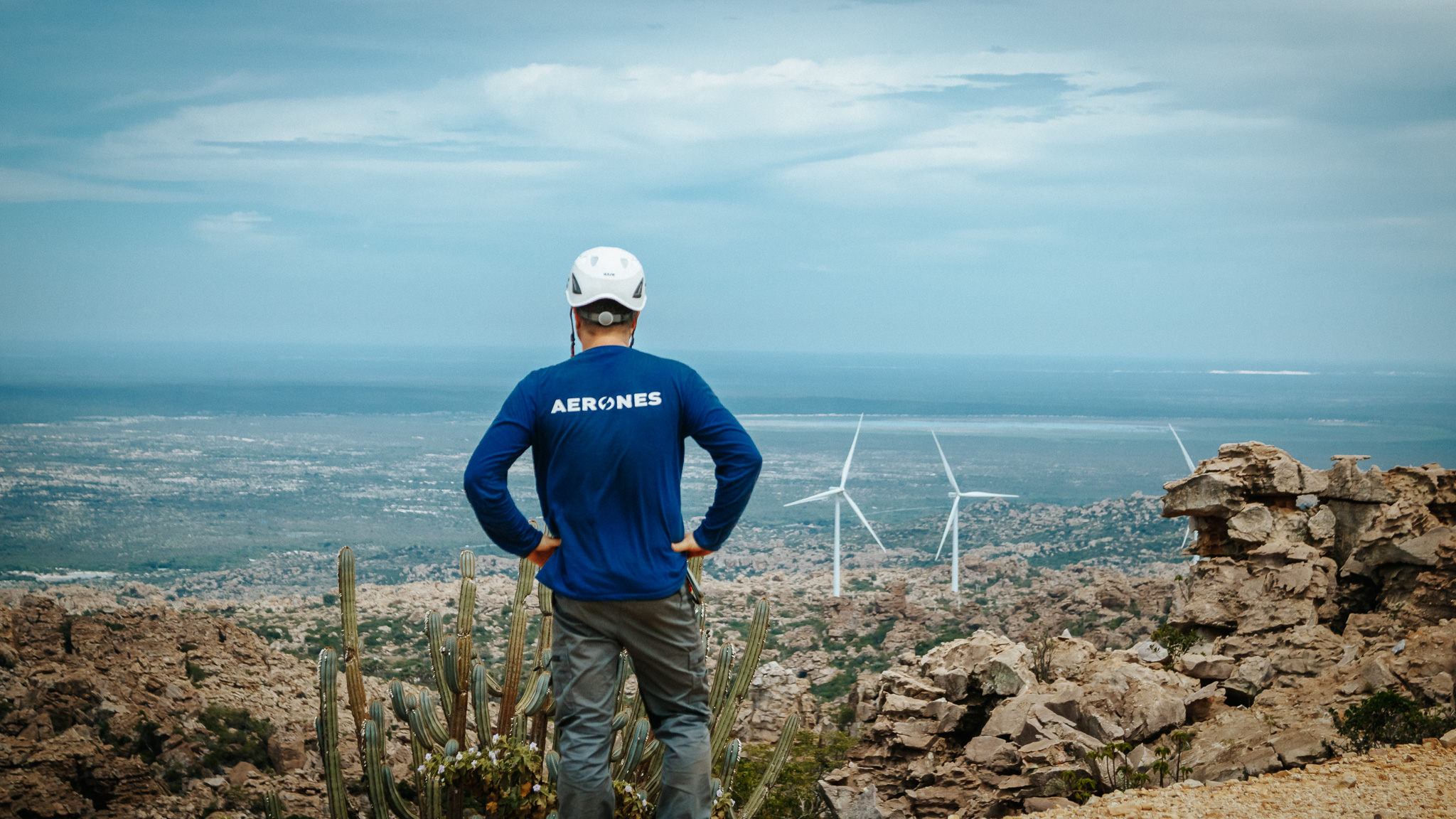 Aerones Technician at a customer site.
Aerones Technician at a customer site.
Aerones’ current technology is designed for onshore wind turbines, but offshore wind is growing quickly, bringing along another big O&M market. The team has been working on a way to apply their unique robotic platform for offshore wind turbines. The project was funded by the EU.
Advice for engineers, researchers and entrepreneurs
We asked one of the co-founders, Putrams, for some advice to our readers. For engineers and researchers looking to join climate tech, he has two suggestions.
First, stay close to the product - an engineer should build the first prototype themselves, experience the problems with the hardware parts and see how it works in the field. When Aerones built the first winch system, they realized that the longest time spent was not the robot doing the task, but the technicians taking care of all the cabling, inspiring many operational and technical workarounds to minimize the cabling setup time.
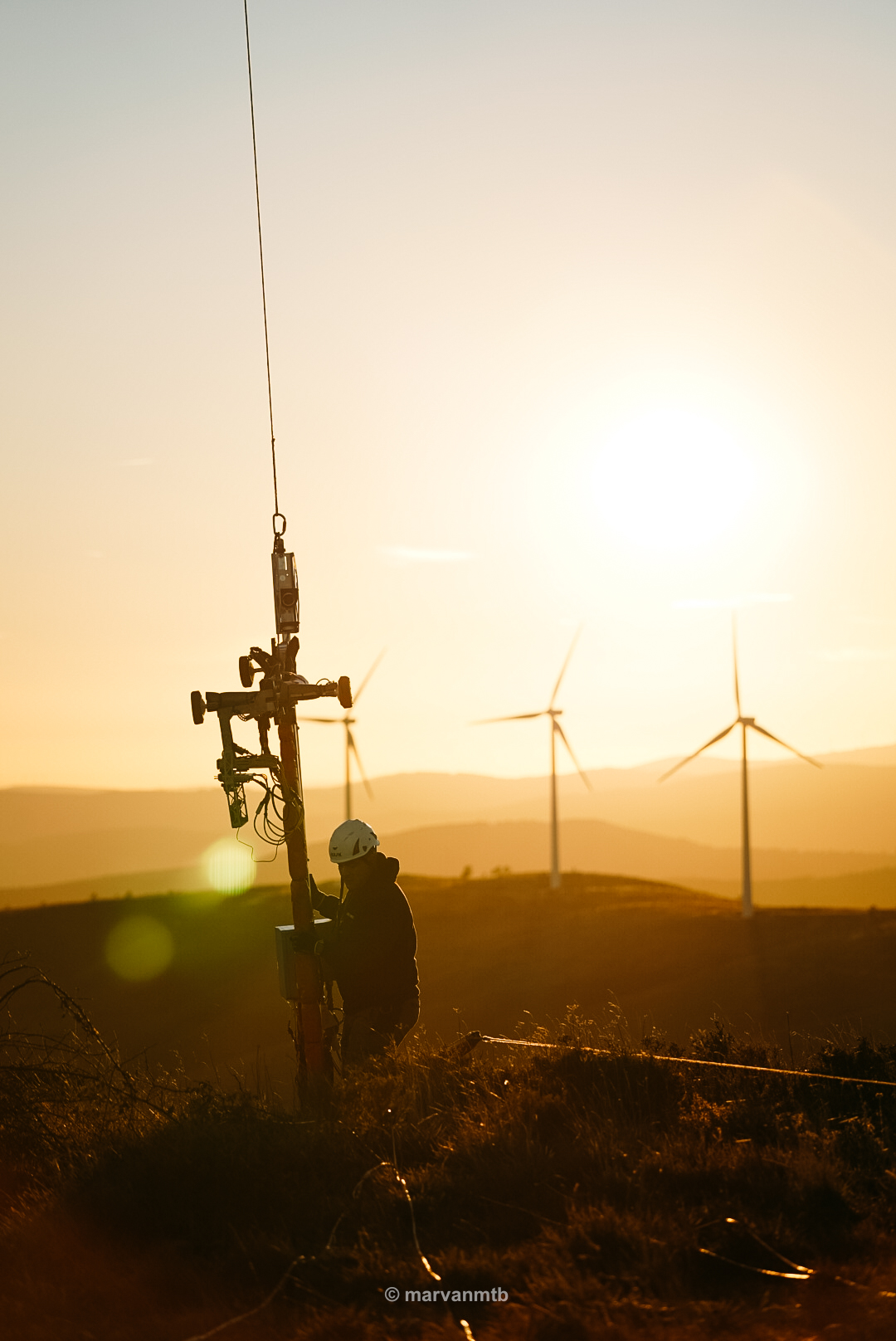 Aerones technician setting up the robot.
Aerones technician setting up the robot.
The second advice is that hardware is crucial for solving climate change. While software has been dominating the startup world, Putrams thinks hardware is far undervalued and encourages people to learn more about and use hardware to solve the real-world problems that we are facing today.
For fellow entrepreneurs, Putrams emphasizes the importance of starting from the problem, not the solution. This was the mistake they made at the beginning, and it was through pivoting around the problem, not the solution, that they were able to find product-market-fit.
Our Takeaways
Here are our takeaways from Aerones’ founding story
- Focus on solving the problem instead of finding a problem for a solution.
- Be ok with making mistakes and be open to new solutions. Don’t be afraid to pivot, as long as you won’t give up.
- Fast iteration speed is crucial to the survival of an early-stage hardware company.
- When building a robot, try to make it as generalizable as possible - the modular design of the Aerones robot platform allows them to onboard new tasks very quickly.
- Don’t be afraid to solve problems from first principles and build something that didn’t exist before - Aerones pivoted their product from a drone to a custom cable-controlled robot system, but it works very well for the tasks needed.
If you are interested in getting involved in climate robotics, we hope you find these takeaways helpful! Don’t forget to like this article at the bottom!
This is the fourth article in our Founder Spotlight series. Check out our other blogs here. To stay up to date on future blogs, subscribe to our newsletter or follow us on LinkedIn!
If you are interested in Aerones, they are planning to expand to the US. You can follow them on LinkedIn or Twitter and stay updated on potential career opportunities.
Acknowledgement
Thanks Kārlis Upsavs, Janis Putrams and the Aerones business development team for sharing their perspectives with us! Thanks Robert Eng for editing suggestions.